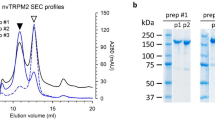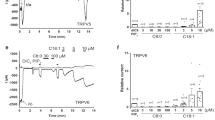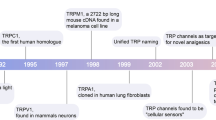Abstract
Transient receptor potential (TRP) proteins form plasma-membrane cation channels that act as sensors for diverse cellular stimuli. Here, we report a novel activation mechanism mediated by cysteine S-nitrosylation in TRP channels. Recombinant TRPC1, TRPC4, TRPC5, TRPV1, TRPV3 and TRPV4 of the TRPC and TRPV families, which are commonly classified as receptor-activated channels and thermosensor channels, induce entry of Ca2+ into cells in response to nitric oxide (NO). Labeling and functional assays using cysteine mutants, together with membrane sidedness in activating reactive disulfides, show that cytoplasmically accessible Cys553 and nearby Cys558 are nitrosylation sites mediating NO sensitivity in TRPC5. The responsive TRP proteins have conserved cysteines on the same N-terminal side of the pore region. Notably, nitrosylation of native TRPC5 upon G protein–coupled ATP receptor stimulation elicits entry of Ca2+ into endothelial cells. These findings reveal the structural motif for the NO-sensitive activation gate in TRP channels and indicate that NO sensors are a new functional category of cellular receptors extending over different TRP families.
This is a preview of subscription content, access via your institution
Access options
Subscribe to this journal
Receive 12 print issues and online access
$259.00 per year
only $21.58 per issue
Buy this article
- Purchase on Springer Link
- Instant access to full article PDF
Prices may be subject to local taxes which are calculated during checkout










Similar content being viewed by others
References
Berridge, M.J., Bootman, M.D. & Lipp, P. Calcium—a life and death signal. Nature 395, 645–648 (1998).
Montell, C., Birnbaumer, L. & Flockerzi, V. The TRP channels, a remarkably functional family. Cell 108, 595–598 (2002).
Clapham, D.E. TRP channels as cellular sensors. Nature 426, 517–524 (2003).
Voets, T., Talavera, K., Owsianik, G. & Nilius, B. Sensing with TRP channels. Nat. Chem. Biol. 1, 85–92 (2005).
Clapham, D.E., Julius, D., Montell, C. & Schultz, G. International Union of Pharmacology. XLIX. Nomenclature and structure-function relationships of transient receptor potential channels. Pharmacol. Rev. 57, 427–450 (2005).
Zhu, X. et al. trp, a novel mammalian gene family essential for agonist-activated capacitative Ca2+ entry. Cell 85, 661–671 (1996).
Vazquez, G., Wedel, B.J., Aziz, O., Trebak, M. & Putney, J.W., Jr. The mammalian TRPC cation channels. Biochim. Biophys. Acta 1742, 21–36 (2004).
Caterina, M.J. et al. The capsaicin receptor: a heat-activated ion channel in the pain pathway. Nature 389, 816–824 (1997).
Patapoutian, A., Peier, A.M., Story, G.M. & Viswanath, V. Thermo TRP channels and beyond: mechanisms of temperature sensation. Nat. Rev. Neurosci. 4, 529–539 (2003).
Jaffrey, S.R., Erdjument-Bromage, H., Ferris, C.D., Tempst, P. & Snyder, S.H. Protein S-nitrosylation: a physiological signal for neuronal nitric oxide. Nat. Cell Biol. 3, 193–197 (2001).
Hess, D.T., Matsumoto, A., Kim, S.O., Marshall, H.E. & Stamler, J.S. Protein S-nitrosylation: purview and parameters. Nat. Rev. Mol. Cell Biol. 6, 150–166 (2005).
Zaidi, N.F., Lagenaur, C.F., Abramson, J.J., Pessah, I. & Salama, G. Reactive disulfides trigger Ca2+ release from sarcoplasmic reticulum via an oxidation reaction. J. Biol. Chem. 264, 21725–21736 (1989).
Moncada, S., Higgs, A. & Furchgott, R. International Union of Pharmacology nomenclature in nitric oxide research. Pharmacol. Rev. 49, 137–142 (1997).
Venema, V.J. et al. Bradykinin stimulates the tyrosine phosphorylation and bradykinin B2 receptor association of phospholipase Cγ1 in vascular endothelial cells. Biochem. Biophys. Res. Commun. 246, 70–75 (1998).
Zachary, I. & Gliki, G. Signaling transduction mechanisms mediating biological actions of the vascular endothelial growth factor family. Cardiovasc. Res. 49, 568–581 (2001).
Koyama, T., Kimura, C., Park, S.J., Oike, M. & Ito, Y. Functional implications of Ca2+ mobilizing properties for nitric oxide production in aortic endothelium. Life Sci. 72, 511–520 (2002).
Hutcheson, I.R. & Griffith, T.M. Central role of intracellular calcium stores in acute flow- and agonist-evoked endothelial nitric oxide release. Br. J. Pharmacol. 122, 117–125 (1997).
Lantoine, F., Iouzalen, L., Devynck, M.A., Millanvoye-Van Brussel, E. & David-Dufilho, M. Nitric oxide production in human endothelial cells stimulated by histamine requires Ca2+ influx. Biochem. J. 330, 695–699 (1998).
Lin, S. et al. Sustained endothelial nitric-oxide synthase activation requires capacitative Ca2+ entry. J. Biol. Chem. 275, 17979–17985 (2000).
Yao, X. & Garland, C.J. Recent developments in vascular endothelial cell transient receptor potential channels. Circ. Res. 97, 853–863 (2005).
Mungrue, I.N. & Bredt, D.S. nNOS at a glance: implications for brain and brawn. J. Cell Sci. 117, 2627–2629 (2004).
Khan, S.A. & Hare, J.M. The role of nitric oxide in the physiological regulation of Ca2+ cycling. Curr. Opin. Drug Discov. Devel. 6, 658–666 (2003).
Volk, T., Mäding, K., Hensel, M. & Kox, W.J. Nitric oxide induces transient Ca2+ changes in endothelial cells independent of cGMP. J. Cell. Physiol. 172, 296–305 (1997).
Chen, J. et al. Autocrine action and its underlying mechanism of nitric oxide on intracellular Ca2+ homeostasis in vascular endothelial cells. J. Biol. Chem. 275, 28739–28749 (2000).
Li, N., Sul, J.Y. & Haydon, P.G. A calcium-induced calcium influx factor, nitric oxide, modulates the refilling of calcium stores in astrocytes. J. Neurosci. 23, 10302–10310 (2003).
Kwan, H.Y., Huang, Y. & Yao, X. Store-operated calcium entry in vascular endothelial cells is inhibited by cGMP via a protein kinase G-dependent mechanism. J. Biol. Chem. 275, 6758–6763 (2000).
Dedkova, E.N. & Blatter, L.A. Nitric oxide inhibits capacitative Ca2+ entry and enhances endoplasmic reticulum Ca2+ uptake in bovine vascular endothelial cells. J. Physiol. (Lond.) 539, 77–91 (2002).
Hara, Y. et al. LTRPC2 Ca2+-permeable channel activated by changes in redox status confers susceptibility to cell death. Mol. Cell 9, 163–173 (2002).
Aarts, M. et al. A key role for TRPM7 channels in anoxic neuronal death. Cell 115, 863–877 (2003).
Okada, T. et al. Molecular cloning and functional characterization of a novel receptor-activated TRP Ca2+ channel from mouse brain. J. Biol. Chem. 273, 10279–10287 (1998).
del Camino, D. & Yellen, G. Tight steric closure at the intracellular activation gate of a voltage-gated K+ channel. Neuron 32, 649–656 (2001).
Sugawara, H., Kurosaki, M., Takata, M. & Kurosaki, T. Genetic evidence for involvement of type 1, type 2 and type 3 inositol 1,4,5-trisphosphate receptors in signal transduction through the B-cell antigen receptor. EMBO J. 16, 3078–3088 (1997).
Choi, Y.B. et al. Molecular basis of NMDA receptor-coupled ion channel modulation by S-nitrosylation. Nat. Neurosci. 3, 15–21 (2000).
Vannier, B., Zhu, X., Brown, D. & Birnbaumer, L. The membrane topology of human transient receptor potential 3 as inferred from glycosylation-scanning mutagenesis and epitope immunocytochemistry. J. Biol. Chem. 273, 8675–8679 (1998).
Chang, A.S., Chang, S.M., Garcia, R.L. & Schilling, W.P. Concomitant and hormonally regulated expression of trp genes in bovine aortic endothelial cells. FEBS Lett. 415, 335–340 (1997).
Greka, A., Navarro, B., Oancea, E., Duggan, A. & Clapham, D.E. TRPC5 is a regulator of hippocampal neurite length and growth cone morphology. Nat. Neurosci. 6, 837–845 (2003).
Xu, L., Eu, J.P., Meissner, G. & Stamler, J.S. Activation of the cardiac calcium release channel (ryanodine receptor) by poly-S-nitrosylation. Science 279, 234–237 (1998).
Broillet, M.C. & Firestein, S. Direct activation of the olfactory cyclic nucleotide-gated channel through modification of sulfhydryl groups by NO compounds. Neuron 16, 377–385 (1996).
Yamada, H. et al. Spontaneous single-channel activity of neuronal TRP5 channel recombinantly expressed in HEK293 cells. Neurosci. Lett. 285, 111–114 (2000).
Jin, Y. et al. Thimerosal decreases TRPV1 activity by oxidation of extracellular sulfhydryl residues. Neurosci. Lett. 369, 250–255 (2004).
Tousova, K., Susankova, K., Teisinger, J., Vyklicky, L. & Vlachova, V. Oxidizing reagent copper-o-phenanthroline is an open channel blocker of the vanilloid receptor TRPV1. Neuropharmacology 47, 273–285 (2004).
Xu, S.Z. et al. Generation of functional ion-channel tools by E3 targeting. Nat. Biotechnol. 23, 1289–1293 (2005).
Zeng, X.H., Xia, X.M. & Lingle, C.J. Redox-sensitive extracellular gates formed by auxiliary β subunits of calcium-activated potassium channels. Nat. Struct. Biol. 10, 448–454 (2003).
Tang, X.D. et al. Haem can bind to and inhibit mammalian calcium-dependent Slo1 BK channels. Nature 425, 531–535 (2003).
Zeng, F. et al. Human TRPC5 channel activated by a multiplicity of signals in a single cell. J. Physiol. (Lond.) 559, 739–750 (2004).
van Rossum, D.B., Patterson, R.L., Ma, H.T. & Gill, D.L. Ca2+ entry mediated by store depletion, S-nitrosylation, and TRPC3 channels. J. Biol. Chem. 275, 28562–28568 (2000).
Thyagarajan, B. et al. Expression of Trp3 determines sensitivity of capacitative Ca2+ entry to nitric oxide and mitochondrial Ca2+ handling: evidence for a role of Trp3 as a subunit of capacitative Ca2+ entry channels. J. Biol. Chem. 276, 48149–48158 (2001).
Koliwad, S.K., Kunze, D.L. & Elliott, S.J. Oxidant stress activates a non-selective cation channel responsible for membrane depolarization in calf vascular endothelial cells. J. Physiol. (Lond.) 491, 1–12 (1996).
Zhang, N., Beuve, A. & Townes-Anderson, E. The nitric oxide-cGMP signaling pathway differentially regulates presynaptic structural plasticity in cone and rod cells. J. Neurosci. 25, 2761–2770 (2005).
Freichel, M. et al. Lack of an endothelial store-operated Ca2+ current impairs agonist-dependent vasorelaxation in TRP4−/− mice. Nat. Cell Biol. 3, 121–127 (2001).
Acknowledgements
We thank D.E. Clapham and C. Strubing for TRPC5-DN, T. Furukawa and M. Nishida for helpful discussions, E. Mori and M. Sasaki for expert experiments and T. Kurosaki for IP3 receptor–deficient DT40 cells. This study was supported by research grants from the Ministry of Education, Culture, Sports, Science and Technology of Japan, the Japan Society for the Promotion of Science, and from the Mitsubishi Foundation.
Author information
Authors and Affiliations
Contributions
T.Y., acquisition, analysis and interpretation of data, and drafting and revision of the manuscript; N.T., S.Y., Y.H., R.I., T.M., M.T., S.S. and Y.S., acquisition, analysis and interpretation of data; Y.M., analysis and interpretation of data, and drafting and critical review of the manuscript.
Corresponding author
Ethics declarations
Competing interests
The authors declare no competing financial interests.
Rights and permissions
About this article
Cite this article
Yoshida, T., Inoue, R., Morii, T. et al. Nitric oxide activates TRP channels by cysteine S-nitrosylation. Nat Chem Biol 2, 596–607 (2006). https://doi.org/10.1038/nchembio821
Received:
Accepted:
Published:
Issue Date:
DOI: https://doi.org/10.1038/nchembio821
This article is cited by
-
TRP channels: a journey towards a molecular understanding of pain
Nature Reviews Neuroscience (2022)
-
The mitochondrial Ca2+ uniporter channel synergizes with fluid shear stress to induce mitochondrial Ca2+ oscillations
Scientific Reports (2022)
-
Neuronal Nitric Oxide Synthase Critically Regulates the Endocannabinoid Pathway in the Murine Cerebellum During Development
The Cerebellum (2022)
-
Role of endothelial cells in the regulation of mechanical microenvironment on tumor progression
Acta Mechanica Sinica (2021)
-
TRPC5 regulates axonal outgrowth in developing retinal ganglion cells
Laboratory Investigation (2020)



